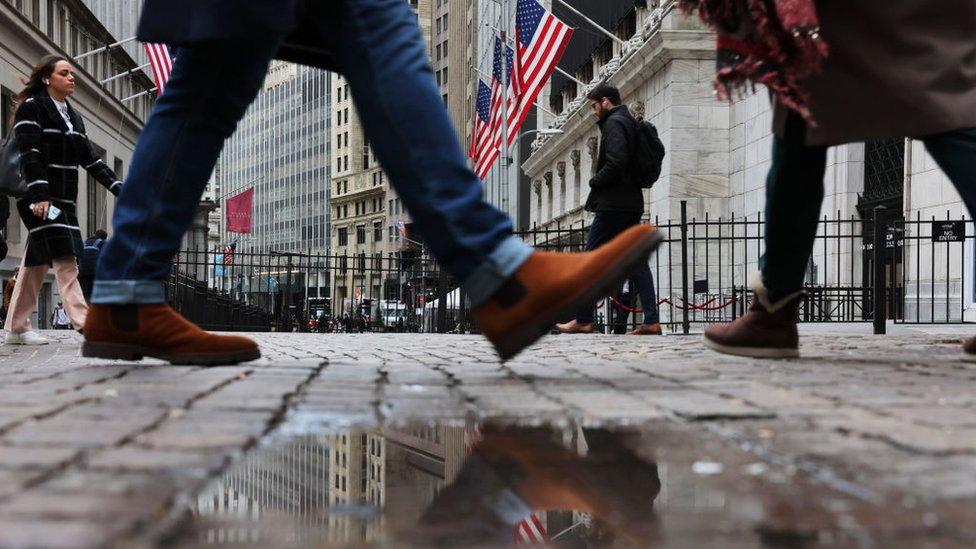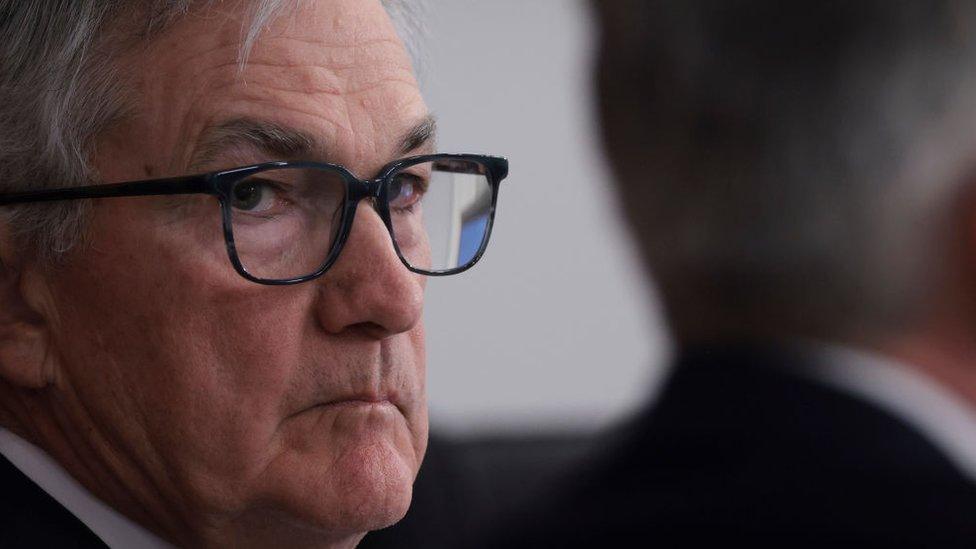US holds interest rates steady in first since 2022
- Published

The US central bank has announced it will hold interest rates steady - the first time it has opted against a rise in more than a year.
The Federal Reserve kept the target for its benchmark rate at 5%-5.25% saying it wanted time to assess the impact of rate hikes so far.
The bank has already raised rates 10 times since March 2022 as it battles to bring inflation under control.
Bank forecasts show most officials expect rates to rise further.
A majority expect the Fed's key rate to stand above 5.5% at the end of the year and one person sees it climbing above 6%.
Federal Reserve chairman Jerome Powell said the bank was still waiting for evidence that inflation was slowing "decisively" - though it has come down sharply from its peak last year, as the shock to food and energy prices from the war in Ukraine subsides.
"We're just not seeing a lot of progress," he said. "We're going to have to keep at it."
Consumer prices rose 4% in the 12 months to May, climbing just 0.1% from a month earlier, the Labor Department reported on Tuesday.
But that remains higher than the 2% rate the bank considers healthy. Prices for many items beyond food and energy continue to rise steadily.
The Fed has already lifted its benchmark rate to the highest levels since 2007 to try to rein in the increases.
Further rises, after a pause, would follow a path carved out by central banks in countries such as Australia and Canada, which recently announced rate hikes following a break, citing stubborn inflation pressures. The European Central Bank is expected to raise rates at its meeting this week.
In the US, Mr Powell said officials wanted time to assess how the economy was adjusting to the shift to higher rates, as the change ripples out to the public in the form of higher costs for mortgages, business loans, credit cards and other borrowing.
"Given how far we've come, it may make sense for rates to move higher but at a more moderate pace," he said.

In theory, higher borrowing costs should reduce demand for loans for homes, business expansions and other activity, eventually cooling the economy and easing pressures pushing up prices.
But despite pockets of pain, such as a sharp slide in home sales, the economy has held up better than many expected so far.
Fed policymakers now expect the economy to grow 1% this year - stronger growth than anticipated in March, according to projections that accompanied the rate announcement. The unemployment rate is also forecast to be 4.1%, lower than previously estimated.
The estimates also show they see less progress controlling inflation than in March.
Mr Powell said what the Fed will do at its next meeting remains a "live" question. He added that he saw no chance that rates would come down this year.
The three major US indexes fell following the announcement, which suggested rates would end the year higher than markets had expected.
"The Fed had to do something to knock market optimism today, otherwise it risked a tougher inflation fight and deeper economic woes down the line," said Seema Shah, chief global strategist at Principal Asset Management.
Charles Lieberman, chief investment officer at Advisors Capital Management, said the pause was a recognition of the risk that the Fed's jump in rates to more than 5% in less than 18 months could trigger an economic slowdown that would lead to millions of job losses.
The bank is also trying to account for the impact of a string of recent bank failures, which could reduce lending further.
"Five percentage points is just absolutely enormous .... So this is a big impact," said Mr Lieberman, who previously worked at the Federal Reserve Bank of New York. "It doesn't mean they're necessarily done."
Diane Swonk, chief economist at KPMG in the US, said the public should not expect a return to lower rates anytime soon.
She said the economy generally has become "much more inflation prone" due to factors such as increased geo-political tensions, a move to more regional supply chains, and extreme weather events upsetting food supplies and prices more frequently.
"You're going to see a much more activist central bank policy with higher bouts of inflation and bouts of rate hikes than we saw from the world we left," she said.
"A pause is not an end," she added. "They don't want to let their guards down yet with regard to inflation."
Related topics
- Published13 June 2023

- Published13 June 2023
